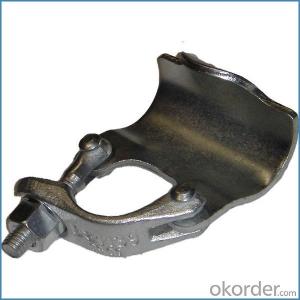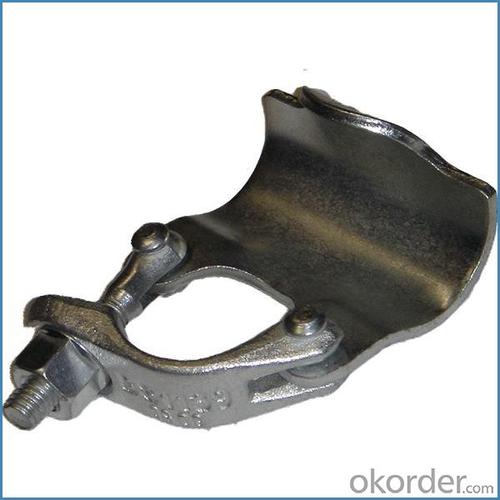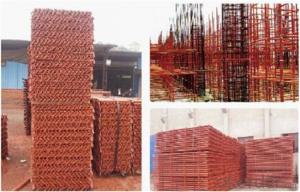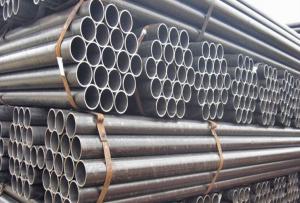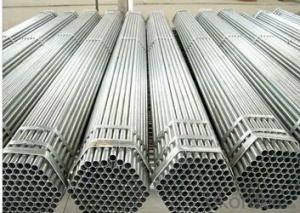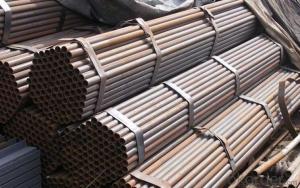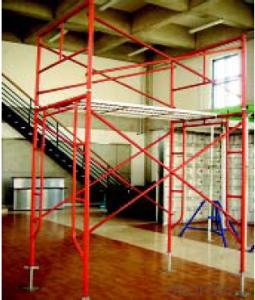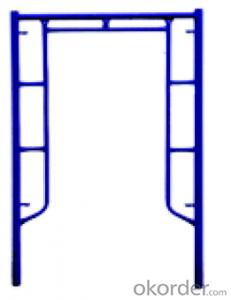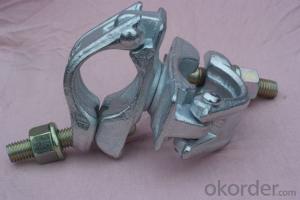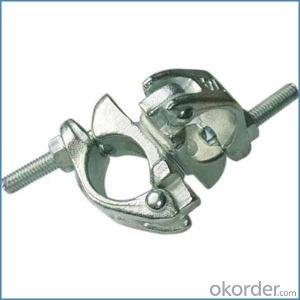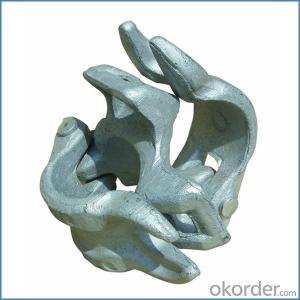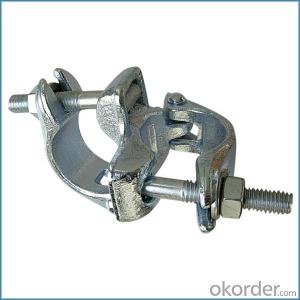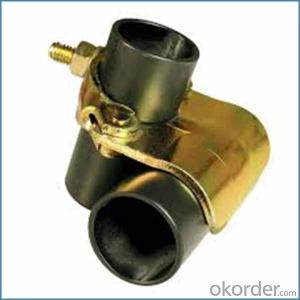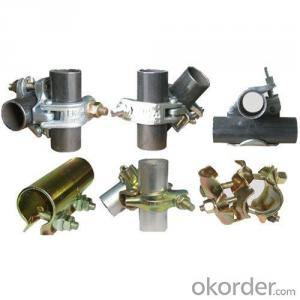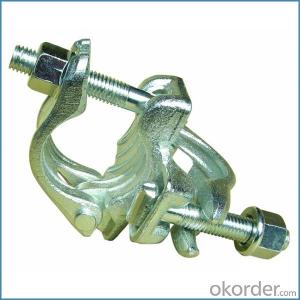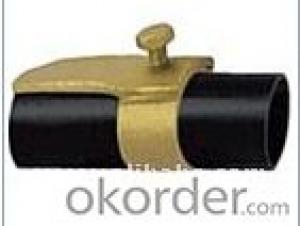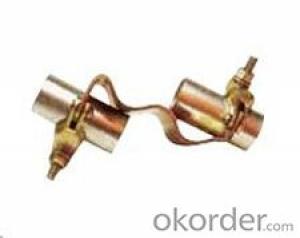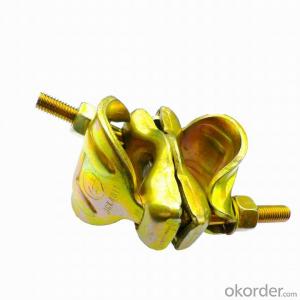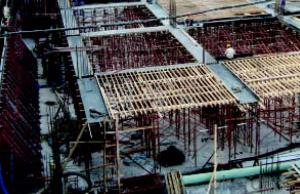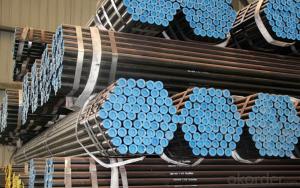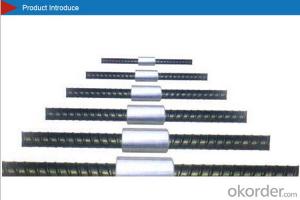Swivel Scaffolding Clamps british German Forged Type
- Loading Port:
- Tianjin
- Payment Terms:
- TT OR LC
- Min Order Qty:
- 1000 kg
- Supply Capability:
- 100000 kg/month
OKorder Service Pledge
OKorder Financial Service
You Might Also Like
Swivel Scaffolding Clamps british German Forged Type
Description
1.The scaffolding coupler is always used to connect the steel pipe as scaffolding system.
2.The often used coupler is swivel coupler and righ angle coupler .
3.We can provide types of scaffolding coupler according to your requirement.
4.Couoler can fix the 48.3mm scaffolding steel pipe tightly and make the whole scaffolding system more steadily.
Feature
(1)Excellent Anti-Breaking—Cold Pressed Steel
(2)Outstanding Resistance Deformation
(3)Strong Anti-Dropping Ability
Photo
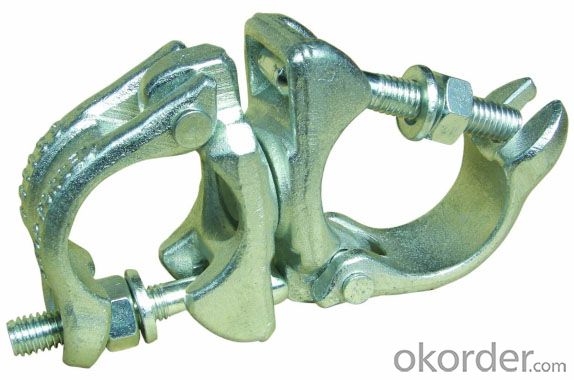
Parameter
| Material | Q235,345steel |
| Size | 48.3mm*48.3mm |
| Surface finish | Galvanized |
| Weight | 1.1kg around |
| Standard | BS1139,EN74 |
| Package | 25pcs/bag,steel pallet |
| Manufacture | As per customer requirement |
| Market | Africa, South America, the Middle East and Asia |
FAQ
Q: Are you a factory or trading company?
We are a state-owned corporation in China,dealing with various kinds of building materials.We have our holding subsidiaries.
Q: Where is your factory located? How can I visit there?
Our factory is located all around China.
Q: Can I get some samples?
Sample is free, customer only pay freight for the first time.
Q: Delivery?
10-30days. (5-15 containers)
Any question,feel free to contact us.
- Q: How do you ensure proper alignment when connecting steel tube couplers in temporary scaffolding?
- To achieve proper alignment when connecting steel tube couplers in temporary scaffolding, it is essential to follow several key steps: 1. Prior to proceeding, inspect the tubes and couplers to ensure they are free from any damage or defects. Replace any damaged or faulty components. 2. Before connecting the couplers, clean the tube ends thoroughly to eliminate any dirt, debris, or rust that may hinder proper alignment. Utilize a wire brush or sandpaper for this task. 3. Properly align the tube ends by ensuring they are straight and parallel to each other. Utilize a spirit level or straightedge to detect any misalignment. 4. Apply a lubricant or grease to the tube ends to facilitate smooth connection. This will ease the process of sliding the couplers onto the tubes and guarantee a proper fit. 5. When connecting the couplers, ensure they are fully engaged with the tube ends. Apply sufficient force or gently tap the coupler onto the tube using a hammer to secure it. 6. Once the couplers are connected, recheck the alignment to verify that the tubes are still straight and parallel. Use a spirit level or straightedge to confirm the alignment. 7. If any misalignment is detected, make the necessary adjustments by loosening the couplers and repositioning the tubes. Repeat the alignment and connection process until proper alignment is achieved. 8. Finally, securely tighten the couplers using an appropriate tool, such as a scaffold wrench, to establish a strong and stable connection. This will prevent any movement or dislodgment of the tubes during use. By adhering to these steps, the safety and stability of the structure can be ensured when connecting steel tube couplers in temporary scaffolding.
- Q: Are steel tube couplers adjustable to different angles?
- No, steel tube couplers are not adjustable to different angles. Steel tube couplers are typically used to connect two steel tubes or pipes in a straight line. They provide a strong and rigid connection, but they do not allow for adjustment in terms of angles. If you need to connect tubes at different angles, other types of couplers, such as swivel couplers or adjustable angle couplers, would be more suitable. These types of couplers allow for adjustable connections at various angles to meet specific project requirements.
- Q: How do steel tube couplers affect the overall flexibility of a scaffolding system?
- Steel tube couplers play a crucial role in determining the overall flexibility of a scaffolding system. These couplers are used to connect steel tubes together, allowing for the construction of various configurations and designs. The type and arrangement of couplers used in a scaffolding system can significantly impact its flexibility. For instance, swivel couplers allow for a 360-degree rotation, enabling the scaffolding to be adjusted to different angles and positions. This flexibility is essential when constructing scaffolding around obstacles or irregular structures. Moreover, steel tube couplers provide a strong and secure connection between tubes, ensuring stability and safety in the scaffolding system. By effectively distributing the load between different components, the couplers enhance the overall strength and rigidity of the scaffolding structure. However, it is important to note that excessive use of couplers can limit the flexibility of the scaffolding system. The more couplers used, the more rigid and less adaptable the structure becomes. Therefore, it is vital to strike a balance between the number of couplers and the desired flexibility of the scaffolding system. In conclusion, steel tube couplers impact the overall flexibility of a scaffolding system by providing the necessary connections between tubes. The type and arrangement of couplers determine the range of angles and positions that can be achieved, while ensuring stability and load distribution. However, it is crucial to find the right balance between coupler usage and flexibility to create a safe and adaptable scaffolding structure.
- Q: Can steel tube couplers be used in scaffolding projects that involve working at great heights or extreme weather conditions?
- Yes, steel tube couplers can be used in scaffolding projects that involve working at great heights or extreme weather conditions. Steel tube couplers are known for their strength and durability, making them suitable for withstanding the demands of such projects. Additionally, their secure connection and resistance to weather elements make them a reliable choice for scaffolding in extreme conditions.
- Q: Are steel tube couplers resistant to wear and tear?
- Steel tube couplers possess a remarkable resistance to wear and tear. Thanks to its durability and strength, steel is an optimal material option for tube couplers. These couplers are specifically designed to endure heavy loads and withstand various environmental conditions. Consequently, they are frequently utilized in construction projects where they are frequently exposed to rigorous use and harsh elements. Steel tube couplers boast an extended lifespan and can withstand the repetitive stress and strain associated with joining and disconnecting tubes. Moreover, they exhibit resistance to corrosion, which further enhances their longevity. All in all, steel tube couplers are an enduring and dependable solution that can withstand the effects of wear and tear over time.
- Q: What are the potential consequences of using damaged or faulty steel tube couplers in scaffolding?
- Using damaged or faulty steel tube couplers in scaffolding can have serious consequences. Firstly, there is a risk of structural collapse. Steel tube couplers are an essential component in scaffolding, as they connect and support the tubes, forming a stable structure. If these couplers are damaged or faulty, they may not provide the necessary strength and stability, leading to a potential collapse of the scaffolding. This can result in injuries or even fatalities for workers or anyone nearby. Secondly, there is an increased risk of accidents and falls. When the couplers are not functioning properly, they may not securely hold the tubes together. This can cause instability in the scaffolding, making it more likely for workers to slip, trip, or fall from heights. Falls from scaffolding can lead to severe injuries, such as broken bones, head trauma, or spinal cord damage. Furthermore, using damaged or faulty steel tube couplers can compromise the overall integrity of the scaffolding system. The couplers play a crucial role in distributing the weight and load across the structure. If these couplers are not in good condition, the weight distribution may become uneven, causing certain areas of the scaffolding to bear excessive weight. This can lead to the failure of specific sections, further increasing the risk of collapse. Moreover, damaged or faulty couplers can affect the stability and balance of the scaffolding. Uneven or loose connections can cause the scaffolding to become wobbly or sway, making it unsafe for workers to move around or perform their tasks. This instability can also make it difficult to safely transport materials and equipment on the scaffolding, increasing the likelihood of accidents or injuries. Lastly, using damaged or faulty steel tube couplers can result in legal and financial consequences. Regulatory bodies, such as occupational health and safety organizations, have strict guidelines and regulations regarding the use of scaffolding equipment. If it is found that damaged or faulty couplers were used, the responsible parties may face penalties, fines, or legal actions. Additionally, the cost of potential injuries, property damages, or lawsuits can have a significant financial impact on the individuals or companies involved. In conclusion, using damaged or faulty steel tube couplers in scaffolding can have severe consequences. It can result in structural collapse, accidents, falls, compromised integrity, instability, and legal or financial repercussions. It is crucial to regularly inspect and maintain the scaffolding equipment to ensure the safety of workers and the surrounding environment.
- Q: What are the common repair or replacement costs associated with steel tube couplers?
- The common repair or replacement costs associated with steel tube couplers may include the cost of purchasing new couplers, labor costs for removing and replacing damaged couplers, transportation costs, and any additional expenses for specialized tools or equipment required for the repair or replacement process. The specific costs can vary depending on factors such as the size and type of couplers, the extent of damage, and the complexity of the installation process.
- Q: Are steel tube couplers compatible with scaffolding boards and platforms?
- Indeed, scaffolding boards and platforms can be effectively affixed to steel tubes through the use of steel tube couplers. The construction industry frequently employs these couplers to establish secure connections between steel tubes within scaffolding systems, thus ensuring stability and safety on the scaffold. By means of these couplers, scaffolding boards and platforms can be effortlessly attached to the steel tubes, creating a reliable and steadfast working surface. Moreover, the adaptability of steel tube couplers allows for their utilization with diverse sizes and types of scaffolding boards and platforms, rendering them compatible with various scaffolding systems.
- Q: Can steel tube couplers be used in scaffolding projects with fragile surfaces?
- Steel tube couplers can be used in scaffolding projects with fragile surfaces, but caution should be exercised. It is important to ensure that the couplers are used properly and that the scaffolding structure is securely attached without causing any damage or stress to the fragile surface. Additionally, protective measures like using padding or rubber mats may be necessary to prevent any potential damage.
- Q: Can steel tube couplers be used in both tube and clamp and system scaffolding?
- Steel tube couplers can be utilized in both tube and clamp as well as system scaffolding. These versatile connectors effectively join tubes in a secure and stable fashion. Their purpose is to establish robust connections between tubes, enabling the construction of diverse scaffolding structures. Regardless of the type of scaffolding, be it tube and clamp or system scaffolding, steel tube couplers serve as the means to connect tubes and establish the essential framework for the scaffolding.
Send your message to us
Swivel Scaffolding Clamps british German Forged Type
- Loading Port:
- Tianjin
- Payment Terms:
- TT OR LC
- Min Order Qty:
- 1000 kg
- Supply Capability:
- 100000 kg/month
OKorder Service Pledge
OKorder Financial Service
Similar products
Hot products
Hot Searches
Related keywords
